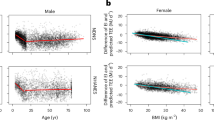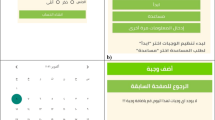Abstract
Background/Objectives:
Dietary assessment in humans is hampered by the phenomena of under and overreporting of energy intake, when food records are used to evaluate habitual dietary intake. Different methods to evaluate mis-reporting have been proposed using cut-offs derived from estimates of reported energy intake and basal metabolic rate, or, from predictions of total energy expenditure. This study compares the effect of using two different cut-off approaches to screen food records for validity, completed by a large cohort of Australian children (n=2460), from Grades 1, 5 and 10 (aged 5–17 years).
Subjects/Methods:
Energy intake was calculated from 24-h food and drink records for each child. These data were screened using the Goldberg and McCrory cut-offs. The effect of using these two cut-offs on the collected dataset was explored by considering the mean and standard deviation of energy intake in each year level before and after the cut-offs were applied.
Results:
The use of the Goldberg cut-off resulted in 9% of the total cohort being classified as underreporters, with 60% of these subjects being in Grade 10. The McCrory cut-offs revealed that overall, 22% of the total cohort underreported EI. 33.3% of Grade 1 children were classified as overreporters with this value falling to about 20% of Grade 10 children, while 10–15% of Grade 1 children underreported, with this figure rising to about 30% in Grade 10.
Conclusions:
Both the Goldberg and McCrory approaches have their advantages and disadvantages, and we suggest that consideration should be given to the reason for screening data before a particular approach is used, with recognition that these methods do differ in their aims and outcomes. The McCrory method consistently classified a greater number of children as underreporters.
This is a preview of subscription content, access via your institution
Access options
Subscribe to this journal
Receive 12 print issues and online access
$259.00 per year
only $21.58 per issue
Buy this article
- Purchase on SpringerLink
- Instant access to full article PDF
Prices may be subject to local taxes which are calculated during checkout
Similar content being viewed by others
References
Abbott RA, Macdonald D, Stubbs CO, Lee A, Harper C, Davies PSW (2007). Healthy Kids Queensland Survey 2006—Summary Report: Queensland Health; Brisbane, Australia.
Black AE (2000). Critical evaluation of energy intake using the Goldberg cut-off for energy intake:basal metabolic rate. A practical guide to its calculation, use and limitations. Int J Obes Relat Metab Disord 24, 1119–1130.
Black AE, Bingham SA, Johansson G, Coward WA (1997). Validation of dietary intakes of protein and energy against 24 h urinary N and DLW energy expenditure in middle-aged women, retired men and post-obese subjects: comparisons with validation against presumed energy requirements. Eur J Clin Nutr 51, 405–413.
Bratteby LE, Sandhagen B, Fan H, Enghardt H, Samuelson G (1998). Total energy expenditure and physical activity as assessed by the doubly labeled water method in Swedish adolescents in whom energy intake was underestimated by 7-d diet records. Am J Clin Nutr 67, 905–911.
Champagne CM, Baker NB, DeLany JP, Harsha DW, Bray GA (1998). Assessment of energy intake underreporting by doubly labeled water and observations on reported nutrient intakes in children. J Am Diet Assoc 98, 426–433.
Davies PSW, Coward WA, Gregory J, White A, Mills A (1994). Total energy expenditure and energy intake in the pre-school child: a comparison. Br J Nutr 72, 13–20.
Davies PSW, Roodveldt R, Marks GC (2001). Standard Methods for the Collection and Collation of Anthropometric Data in Children/Prepared by Peter SW Davies, Rebecca Roodveldt and Geoff Marks. Departmetn of Health and Aged Care: Canberra.
Goldberg GR, Black AE, Jebb SA, Cole TJ, Murgatroyd PR, Coward WA et al. (1991). Critical evaluation of energy intake data using fundamental principles of energy physiology: derivation of cut-off to identify under-recording. Eur J Clin Nutr 45, 569–581.
Goris AH, Westerterp-Plantenga MS, Westerterp KR (2000). Undereating and underrecording of habitual food intake in obese men: selective underreporting of fat intake. Am J Clin Nutr 71, 130–134.
Haggarty P, McGaw BA, Maughan RJ, Fenn C (1988). Energy expenditure of elite female athletes measured by the doubly labelled water method. Proc Nutr Soc 47, 35A.
Hill RJ, Davies PS (1999). The validity of a four day weighed food record for measuring energy intake in female classical ballet dancers. Eur J Clin Nutr 53, 752–753.
Hill RJ, Davies PSW (2001). The validity of self reported energy intake as determined using the doubly labelled water technique. Br J Nutr 85, 415–430.
Huang TT, Howarth NC, Lin B-H, Roberts SB, McCrory MA (2004). Energy intake and meal portions: associations with BMI percentile in US Children. Obes Res 21, 1875–1885.
Institute of Medicine (2002). Dietary Reference Intakes for Energy Carbohydrate, Fiber, Fat, Fatty Acids, Cholesterol, Protein, and Amino Acids, Part 1. National Academy of Sciences: Washington, DC.
Livingstone MB, Black AE (2003). Markers of the validity of reported energy intake. J Nutr 133 (Suppl 3), 895S–920S.
Livingstone MB, Prentice AM, Strain JJ, Coward WA, Black AE, Barker ME et al. (1990). Accuracy of weighed dietary records in studies of diet and health. Br Med J 300, 708–712.
McCrory M, Hajduk C, Roberts S (2002). Procedures for screening out inaccurate reports of dietary energy intake. Public Health Nutr 5 (6A), 873–882.
Prentice AM, Black AE, Coward WA, Davies HL, Goldberg GR, Murgatroyd PR et al. (1986). High levels of energy expenditure in obese women. Br Med J (Clin Res Ed) 292, 983–987.
Rennie KL, Coward A, Jebb SA (2007). Estimating under-reporting of energy intake in dietary surveys using an individualised method. Br J Nutr 97, 1169–1176.
Schofield WN (1985). Predicting basal metabolic rate, new standards and review of previous work. Hum Nutr Clin Nutr 39c (Suppl 1), 5–41.
Ventura AK, Loken E, Mitchell DC, Smiciklas-Wright H, Birch LL (2006). Understanding reporting bias in the dietary recall data of 11-year-old girls. Obesity 14, 1073–1084.
Acknowledgements
Queensland Health commissioned and funded the Healthy Kids Queensland Survey. A Steering Committee including representation from Queensland Health, Education Queensland, Independent Schools Queensland, the Queensland Catholic Education Commission and the Queensland Department of Local Government Sport and Recreation provided advice, guidance and support regarding the survey.
Author information
Authors and Affiliations
Corresponding author
Ethics declarations
Competing interests
The authors have no conflicts of interest to declare.
Rights and permissions
About this article
Cite this article
Elliott, S., Davies, P., Nambiar, S. et al. A comparison of two screening methods to determine the validity of 24-h food and drink records in children and adolescents. Eur J Clin Nutr 65, 1314–1320 (2011). https://doi.org/10.1038/ejcn.2011.126
Received:
Revised:
Accepted:
Published:
Issue date:
DOI: https://doi.org/10.1038/ejcn.2011.126
Keywords
This article is cited by
-
A systematic review of the validity of dietary assessment methods in children when compared with the method of doubly labelled water
European Journal of Clinical Nutrition (2020)



